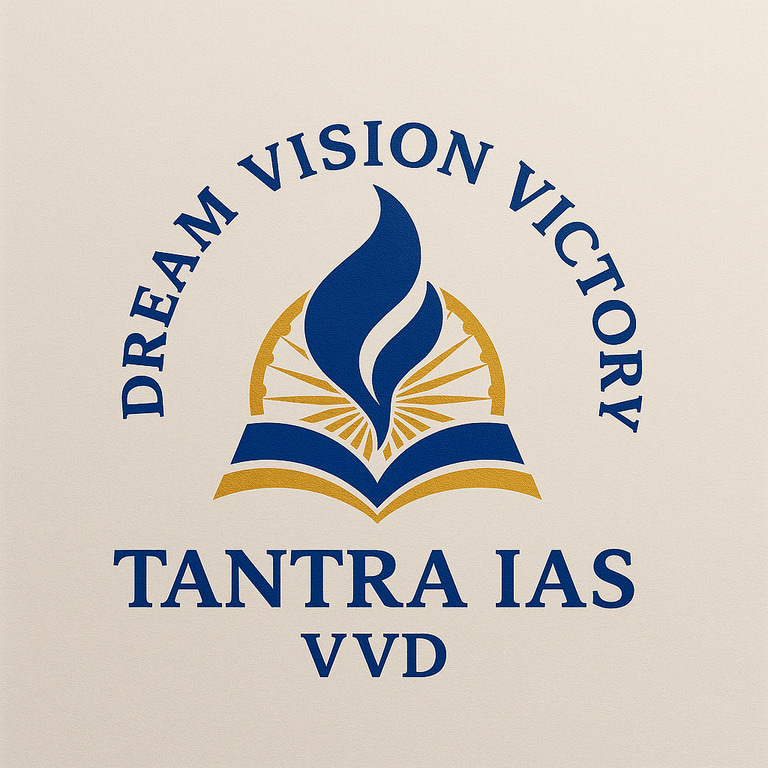THE STORY OF THE CALORIE: SCIENCE, SOCIETY & SELF-CONTROL
Theme: Science & Technology | Ethics in Nutrition | History of Scientific Ideas
📌 Context
The calorie, now an everyday metric of diet and energy, was born not in kitchens but in 18th-century laboratories. From being a scientific tool to measure energy, it evolved into a social and moral symbol of health, productivity, and body image — illustrating how scientific concepts acquire cultural power.
🧪 Scientific Evolution
Antoine Lavoisier (1780s): Linked breathing and metabolism to combustion — laid foundation for calorimetry.
Max Rubner & Wilbur Atwater (19th century): Quantified energy in food → “calorie” introduced to U.S. food labels.
The calorie became central to nutrition science, industrial labour studies, and early public health reforms.
💃 Social Transformation
1920s: Physician Lulu Hunt Peters’ bestseller Diet and Health turned calorie counting into a symbol of modernity, self-discipline, and female liberation — merging science, fashion, and morality.
“Counting calories” became not just health arithmetic but a language of self-control, influencing body ideals and consumption ethics.
🧭 Ethical & Governance Dimensions
GS4 Lens: Calorie counting evolved into a form of “moral arithmetic” — tying self-worth to restraint and discipline.
Reflects how science can influence values, body politics, and societal norms.
Raises ethical questions on body image, social pressure, and scientific neutrality.
🧠 Modern Scientific Reassessment (2020s)
“Calories in, calories out” now seen as oversimplified.
Nutrigenomics & Nutrimetabolomics: Study how genes interact with nutrition.
Personalized diet science shows calorie values differ by metabolism, gut bacteria, and food processing.
Illustrates limits of reductionist science — calls for holistic models of health and well-being.
💡 UPSC RELEVANCE
GS Paper 3:
Science & Technology in everyday life.
Historical evolution of scientific measurement systems.
Nutrition, health, and societal implications.
GS Paper 4:
Ethics of self-regulation, societal ideals, and scientific responsibility.
Interplay between science and human values.
Prelims Pointers:
Calorie: Unit of energy (1 cal = 4.184 joules).
Inventor: Antoine Lavoisier.
First practical use: Wilbur Atwater’s calorimeter (1890s).
Modern fields: Nutrigenomics, Nutrimetabolomics.
🧩 Topper’s Toolkit (Tantra Add-Ons)
Keywords: Calorimetry | Nutritional Ethics | Science of Self-Control | Anthropometry | Nutrigenomics
Quote: “Science shapes societies as much as it explains them.”
Case Insight: “Calories as governance” — early 20th-century public health reforms tied moral worth to energy efficiency.


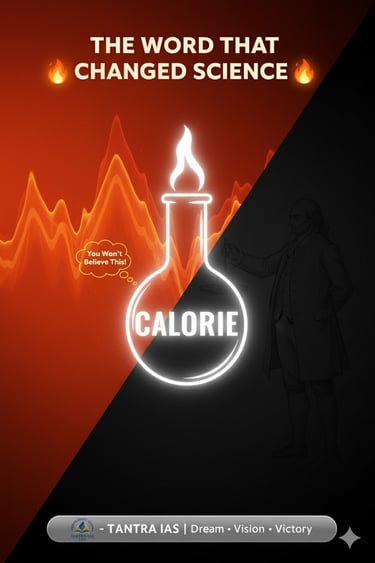

SPECIAL INTENSIVE REVISION (SIR) OF ELECTORAL ROLLS 2025
Theme: Electoral Reforms | Transparency & Accountability in Governance
📌 Context
The Election Commission of India (ECI) has launched a Pan-India Special Intensive Revision (SIR) of the electoral rolls to ensure error-free, transparent, and updated voter lists ahead of upcoming elections.
This follows pilot exercises in Bihar, where over 69 lakh duplicate/ineligible entries were removed and ~7.43 crore valid voters were confirmed.
⚙️ What is SIR?
A special, field-based revision drive under Section 21 of the Representation of the People Act, 1950.
Conducted beyond the normal annual revision when large-scale corrections or deletions are required.
Focuses on removal of duplicates, deceased, shifted, or ineligible voters and inclusion of first-time and migrant voters.
🧭 Objectives
✅ Purification of Voter Rolls: Ensure one-person-one-vote principle.
✅ Inclusion & Accessibility: Add eligible young voters (18–19 years).
✅ Transparency: House-to-house verification by Booth Level Officers (BLOs).
✅ Digital Integration: Use of Voter Helpline App & National Grievance Service Portal for self-verification.
⚖️ Legal & Constitutional Framework
Article 324: Powers of ECI to supervise, direct, and control elections.
Representation of the People Act, 1950: Section 21 – Electoral roll preparation and revision.
2003 Rules & 2016 Guidelines: Provide for Special Revision under extraordinary circumstances.
🔍 Recent Developments (2024–25)
Bihar: 69 lakh deletions; SC asked ECI to focus on “inclusion, not exclusion.”
West Bengal: SIR preparations reviewed; digital verification system introduced.
Supreme Court Monitoring: Ensuring no eligible voter is disenfranchised.
Pan-India Launch: Planned across all States/UTs by mid-2025.
💡 Significance
🌐 Strengthens democratic integrity and public confidence in electoral process.
📊 Enhances data accuracy for election management.
👥 Promotes youth participation and inclusivity.
⚙️ Aligns with Digital India for real-time voter authentication.
⚠️ Concerns & Criticism
⚠️ Allegations of mass deletions without due verification (Bihar case).
⚠️ Risk of bureaucratic overreach and voter disenfranchisement.
⚠️ Political sensitivity in states with migrant populations.
⚠️ Need for better grievance redressal and citizen awareness.
🧠 UPSC RELEVANCE
GS Paper 2:
Electoral reforms, transparency in governance, role of ECI.
Democratic participation, trust in institutions.
Prelims Pointers:
Body: Election Commission of India.
Legal Basis: Article 324, RP Act 1950 (Sec. 21).
Purpose: Clean, inclusive voter lists.
Current Data: Bihar – 7.43 crore voters post-SIR; 69 lakh deletions.
Apps Used: Voter Helpline App, Garuda App.
🧩 Topper’s Toolkit
Keywords: Electoral Integrity | Clean Voter Roll | Inclusion over Exclusion | Voter Verification
Quote: “Free and fair elections begin with free and fair lists.”
Case Study (2025): Bihar SIR controversy – highlighted balance between accuracy and inclusion, prompting SC oversight.
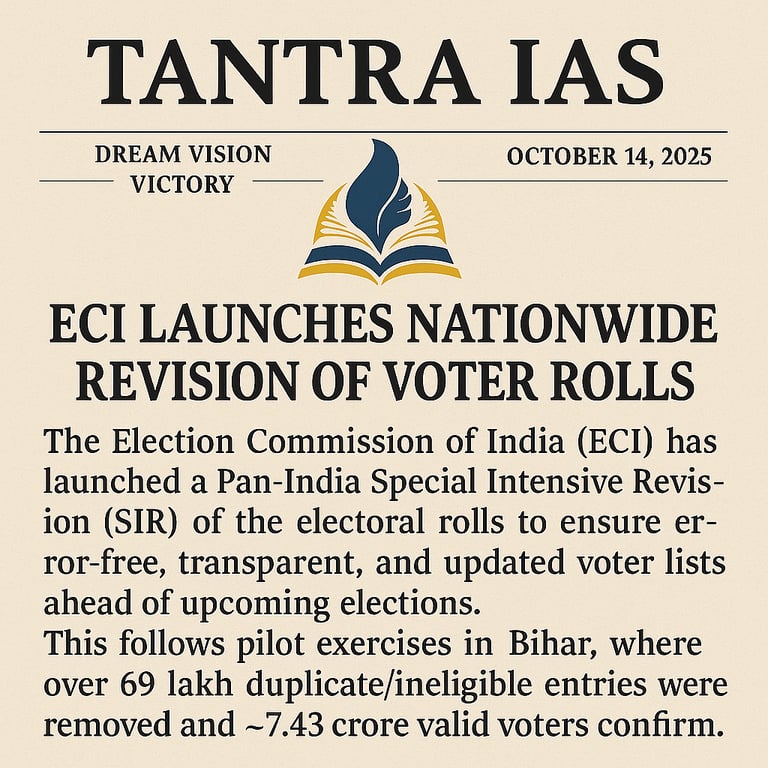

“MAITRI II: INDIA’S NEW FRONTIER IN ANTARCTICA”
Theme: Science & Technology | Environment | International Relations
📌 Context
The Finance Ministry has approved the establishment of Maitri II, India’s fourth Antarctic research base, to be built in eastern Antarctica by January 2029.
🔹 Outlay: ₹2,000 crore (over 7 years)
🔹 Implementing Agency: NCPOR (Goa) under the Ministry of Earth Sciences
🌍 Background
India’s first base Dakshin Gangotri (1983) — decommissioned.
Maitri (1989) and Bharati (2012) — currently operational.
Maitri II will advance India’s long-term polar research and commitments under the Antarctic Treaty (1959) and Antarctic Act (2022).
🔬 Features of Maitri II
✅ Located in eastern Antarctica (near Schirmacher Oasis)
✅ Focus on climate change, glaciology, ocean–atmosphere dynamics, biodiversity, and renewable energy
✅ Equipped for remote-sensing studies, sustainable waste management, & zero-carbon operations
✅ Will strengthen India’s role in global polar research networks
💡 Significance
🌡️ Enhances understanding of polar-climate interactions with the Indian Ocean.
🌊 Strengthens India’s scientific diplomacy and environmental leadership.
⚙️ Encourages innovation in clean energy, logistics, and extreme-climate infrastructure.
🧭 UPSC MAINS RELEVANCE
GS Paper 1: Geophysical phenomena, polar geography.
GS Paper 3: Scientific Research & Innovation, Environmental protection & climate cooperation, India’s Antarctic policy & international obligations.
🧾 UPSC PRELIMS RELEVANCE
Maitri II: India’s fourth Antarctic research base.
Implementing Agency: National Centre for Polar and Ocean Research (NCPOR), Ministry of Earth Sciences.
Existing Bases: Maitri (1989), Bharati (2012); Dakshin Gangotri (1983) – now decommissioned.
Antarctic Act 2022: Provides legal framework for India’s Antarctic activities.
Antarctic Treaty 1959: Ensures peaceful scientific cooperation; India a signatory since 1983.
Location: Eastern Antarctica → Schirmacher Oasis region.
🧠 Topper’s Toolkit (Tantra Signature)
Keywords: Polar Diplomacy | Antarctic Act 2022 | Sustainable Research | Climate Governance
Quote: “Science in service of sustainability defines India’s polar mission.”
Diagram Idea: Map showing India’s 3 operational bases + proposed Maitri II (East Antarctica).
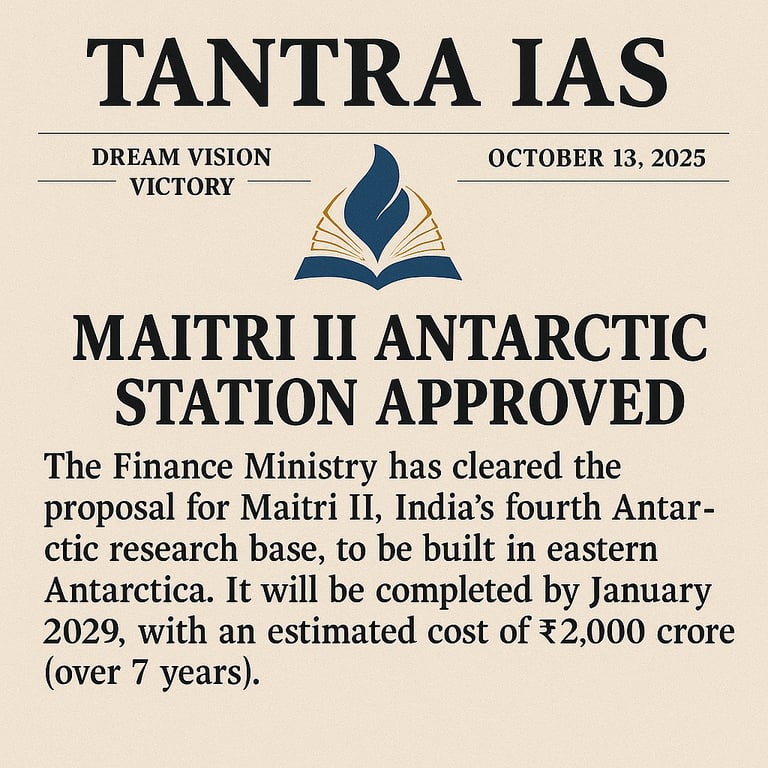

“BASE YEAR REBOOT: Aligning Numbers with New India”
Theme: Growth & Development | Industrial Policy | Economic Indicators
📌 Context
The Ministry of Statistics and Programme Implementation (MoSPI) has initiated the process to revise the base year of the Index of Industrial Production (IIP) from 2011–12 to 2022–23.
This aims to better reflect current industrial structure, technological shifts, and new production patterns in India.
⚙️ About IIP
Published by: NSO, MoSPI
Measures: Volume of production in manufacturing, mining, and electricity.
Base Year (current): 2011–12
Use: Serves as a short-term indicator of industrial growth and contributes to GDP estimates and policy planning.
📈 Why Base Year Revision?
Structural changes post–COVID (Make in India, PLI, MSME expansion).
Inclusion of new industries and emerging technologies (EVs, LEDs, semiconductors).
Alignment with latest GDP series and International Recommendations (UN, IRIP 2010).
Reflects sectoral diversification — services, green manufacturing, and data-driven innovation.
💡 Key Changes Proposed
✅ Expansion of product coverage – inclusion of EVs, batteries, chips, solar modules.
✅ Elimination of obsolete items.
✅ Integration of GST and ASI data for real-time accuracy.
✅ Seasonally-adjusted IIP for improved forecasting.
✅ Use of digital factory returns to ensure reliability.
🧭 UPSC Relevance
GS Paper 3:
Inclusive growth & industrial policy.
Role of data in economic governance.
Government reforms for productivity and competitiveness.
Prelims:
Publisher: NSO (MoSPI)
Frequency: Monthly
Current Base Year: 2011–12 (proposed: 2022–23)
Three sectors: Mining, Manufacturing, Electricity
🔍 Value Addition (Toppers’ Toolkit)
Keywords: Data-driven Industrial Policy | Structural Change | Economic Modernisation
Diagram Idea: Flowchart — IIP Revision → Better Data → Informed Policy → Industrial Growth
🧠 Takeaway
Updating IIP’s base year to 2022–23 is a timely reform to capture India’s new-age industrial economy, ensuring evidence-based policymaking and stronger growth forecasting for the decade ahead.
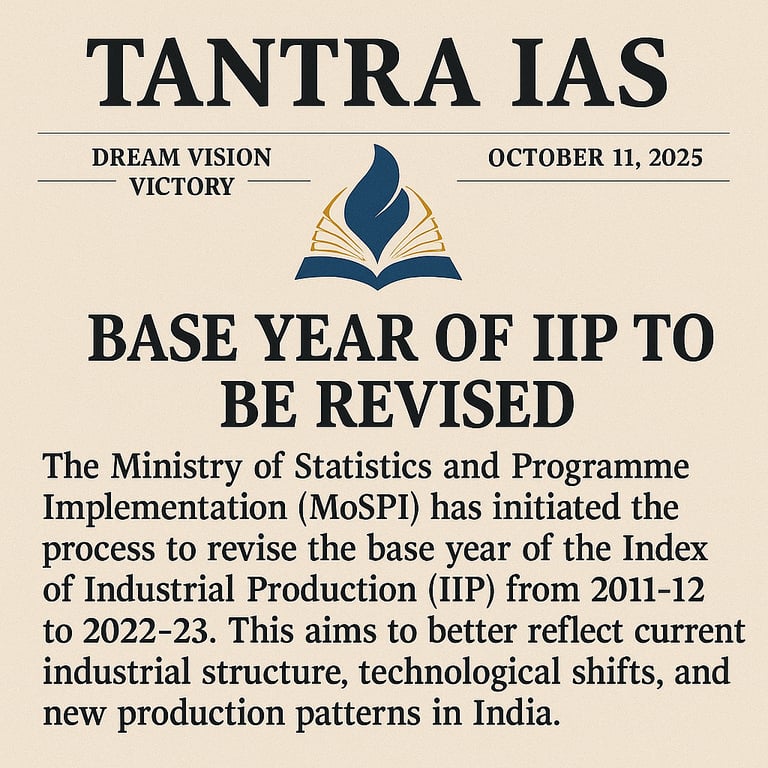

NOBEL PEACE PRIZE 2025: MARIA CORINA MACHADO
Theme: Democracy | Ethics in Public Life | International Relations
📌 Context:
The 2025 Nobel Peace Prize was awarded to Maria Corina Machado, Venezuelan opposition leader, for her non-violent struggle to defend democracy and human rights against the authoritarian regime of Nicolás Maduro.
Her recognition highlights the ethical and civic responsibility of individuals in protecting democratic institutions.
⚙️ Facts (Prelims Focus)
Awarded by: Norwegian Nobel Committee, Oslo.
Country: Venezuela.
Field: Defence of democracy, civic courage, and political freedom.
First Venezuelan laureate to receive the Nobel Peace Prize.
Prize citation: “For her unwavering fight for democracy, truth, and the rule of law.”
🧭 UPSC Mains Relevance:
GS Paper 2:
Role of individuals and civil society in democratic strengthening.
Authoritarianism vs participatory governance.
Global efforts toward peace and human rights.
GS Paper 4:
Ethical courage and integrity in public life.
Moral duty under political oppression.
Leadership rooted in justice and truth.
💡 Significance:
✅ Symbolises the moral defence of democracy amid rising global authoritarianism.
✅ Reinforces values of freedom, accountability, and ethical leadership.
✅ Highlights how individual conscience can inspire institutional reform.
🎯 Prelims Takeaways:
Nobel Peace Prize 2025: Maria Corina Machado (Venezuela).
Awarded for: Defence of democracy and civil rights.
Presented in: Oslo, Norway.
Associated Concept: Civic resistance, human rights, ethical governance.
🧠 Toppers’ Toolkit:
Keyword: Civic Courage | Democratic Ethics | Moral Resistance
Quote: “Democracy must be defended every day.” — Nobel Committee
Diagram Idea: Concentric layers — Individual → Civil Society → Global Peace.
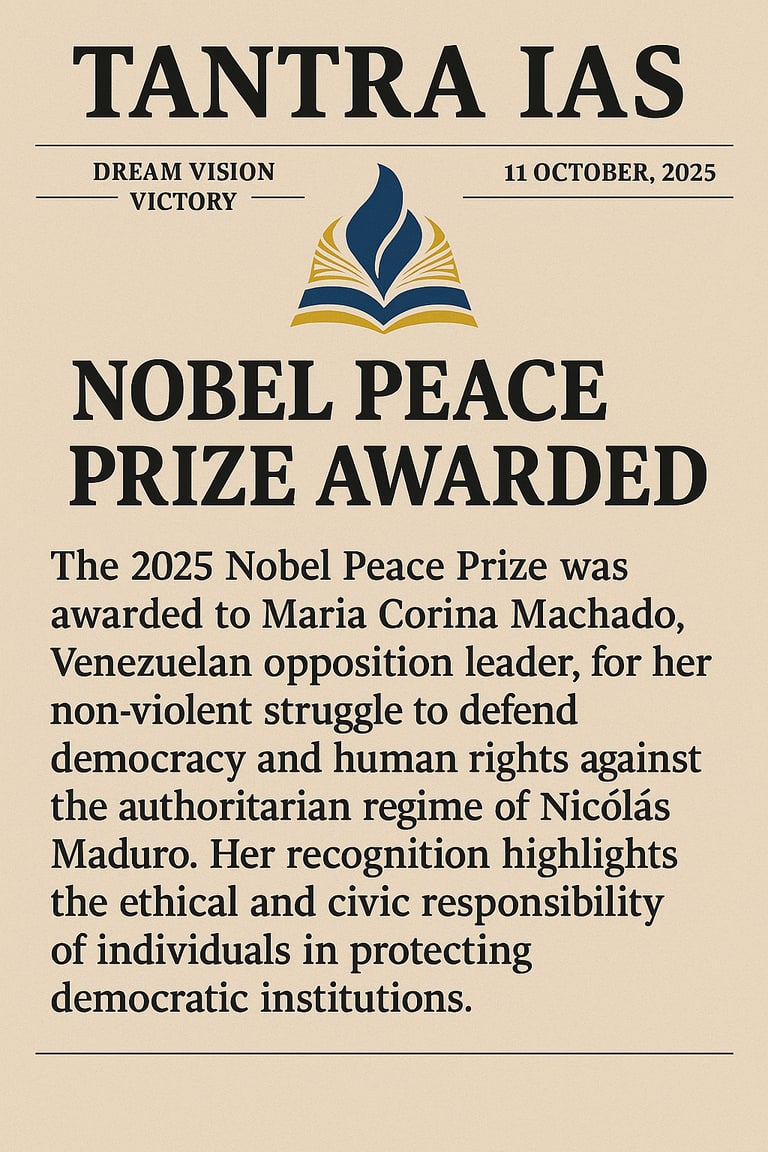

KERALA’S RIGHT TO PUBLIC SERVICE BILL, 2025
Theme: Governance | Accountability | Citizen-Centric Administration
🧠 Context
The Kerala Legislative Assembly has passed the Right to Public Service Bill (2025), which ensures time-bound delivery of government services, introduces penalties for delays, and creates a robust grievance redressal mechanism.
Chief Minister Pinarayi Vijayan called it a major step in ensuring transparency, accountability, and efficiency in governance — making it a citizen’s right to receive timely public services.
📜 Key Provisions
🔹 Right to Timely Services:
Citizens can demand notified public services within a prescribed time frame.
🔹 Penalty for Delay:
Officials failing to deliver services within the deadline will face fines or disciplinary action.
🔹 Appellate Mechanism:
Aggrieved citizens can appeal to higher authorities through a Commission for Public Service Delivery.
🔹 Designated Officers:
Each service will have an officer responsible for its timely provision; similar to RTI’s “Public Information Officer” model.
🔹 Transparency Mandate:
Departments must publicly display service timelines and officer responsibilities.
🧭 UPSC Mains Relevance
GS Paper 2:
Governance: Transparency, accountability, and citizen charter.
E-Governance: Time-bound delivery of services via digital platforms.
Constitution: Article 38 (social justice), Article 41 (right to work, education, and assistance).
⚙️ Comparative Insights
✅ Madhya Pradesh (2010) and Bihar (2011) pioneered similar Right to Service Acts.
✅ Kerala’s model strengthens the citizen’s legal recourse by adding a penalty clause and public accountability charter.
💡 Significance
✅ Empowers citizens to demand efficient governance.
✅ Builds trust and responsiveness in administration.
✅ Reduces corruption and bureaucratic delay.
✅ Enhances public service ethics and accountability.
⚖️ Challenges
⚠️ Possible bureaucratic resistance and delay in grievance disposal.
⚠️ Capacity constraints in monitoring compliance.
⚠️ Digital access gap for rural citizens.
🧩 Way Forward
🌐 Integrate with e-governance portals (Kerala Citizen Portal) for faster grievance tracking.
👥 Train officials in service ethics and citizen facilitation.
📊 Periodic audit and citizen feedback for improvement.
💬 Conclusion
Kerala’s Right to Public Service Bill reinforces the principle that “delay in service is denial of justice.” It marks a shift from a bureaucratic state to a citizen-centric democracy, institutionalising governance as a right.
🧠 Topper’s Toolkit (Value Add)
Keyword: Citizen Charter, Service Accountability, Time-bound Governance.
Quote: “Good governance is not an act of grace — it is a citizen’s right.”
Diagram Idea: Flowchart — Citizen → Application → Designated Officer → Timeline → Appeal Mechanism → Accountability Loop.
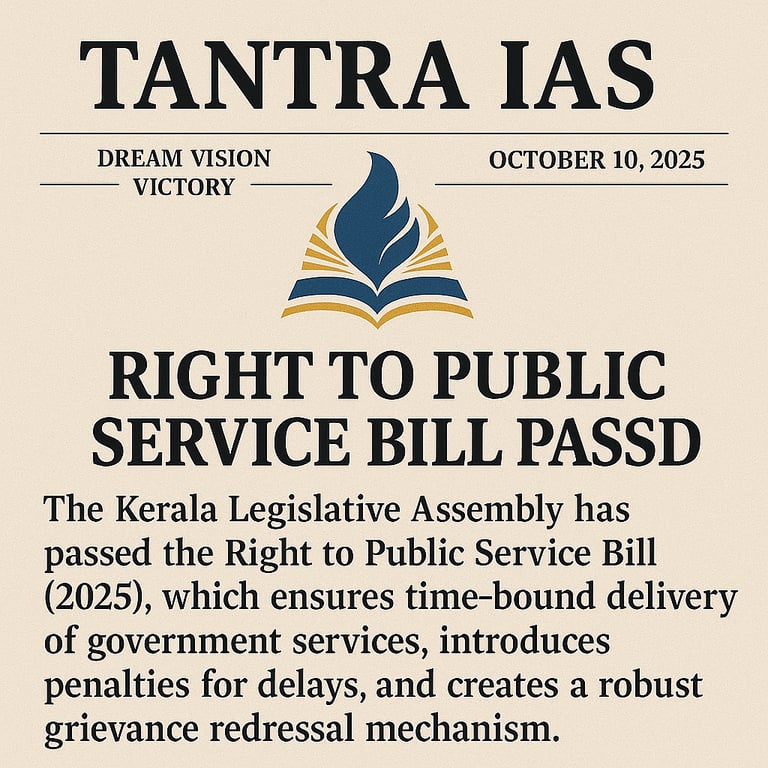

SC STAYS ARAVALLI SAFARI PARK PROJECT: ECO-TOURISM VS ECOLOGY
Theme: Environment | Sustainable Development | Conservation vs Development
🧠 Context
The Supreme Court has directed the Haryana Government to pause work on the proposed Aravalli Jungle Safari Project, citing concerns over environmental impact and violation of forest and wildlife protection norms.
The project, envisioned as India’s largest curated safari park across 10,000 acres in the Aravalli range (Gurugram–Nuh districts), was inspired by global models like Dubai’s Safari Park but faced criticism for potential ecological destruction.
📍 About the Project
Area: 10,000+ acres across Gurugram and Nuh.
Aim: To create a world-class eco-tourism hub combining safaris, adventure zones, and conservation education.
Estimated Cost: ₹500–₹1000 crore.
Funding: PPP (Public–Private Partnership) model.
Claimed Objective: “Maximising recreation and conservation synergy.”
⚖️ Supreme Court’s Concerns
✅ Whether the project violates Aravalli Notification (1992) and Forest (Conservation) Act, 1980.
✅ Fear of deforestation, fragmentation of wildlife corridors, and commercialisation of fragile ecosystems.
✅ Sought Environmental and Forest Clearances before proceeding.
🌱 Environmental Significance of Aravallis
Acts as green lungs for NCR — absorbs pollution and checks desertification.
Groundwater recharge and biodiversity hotspot (leopards, hyenas, peacocks, etc.).
Natural barrier against desert expansion from Rajasthan.
Over 20% forest cover already lost due to mining and construction.
🧩 Petitioners’ Argument
The park risks being an “eco-disaster in the name of eco-tourism.”
Violates principles of “Sustainable Development” and “Precautionary Approach.”
May threaten wildlife corridors connecting Sariska–Nuh–Asola–Bhatti Sanctuary.
🧭 Government Argument
Claims it promotes eco-tourism, jobs, and awareness.
Part of Haryana’s Vision 2047 for sustainable recreation.
Government assures adherence to green norms and sustainable models like safari zones and conservation parks.
📚 UPSC Mains Relevance:
GS Paper 3:
Conservation, environmental pollution, and degradation.
EIA, Environmental Governance, Wildlife Corridors.
GS Paper 2:Balance between developmental priorities and environmental ethics.
⚖️ Ethical & Policy Insight:
“When nature becomes a spectacle, conservation turns into commerce.”
Keyword: Sustainable Tourism vs Commercial Eco-tourism
Concept: Ecological Carrying Capacity
🌍 Way Forward
✅ Conduct Comprehensive EIA with wildlife impact analysis.
✅ Implement carrying capacity limits before eco-tourism expansion.
✅ Promote community-based ecotourism with local participation.
✅ Strengthen Aravalli Biodiversity Conservation Authority.
💬 Conclusion
The Aravalli case highlights India’s broader dilemma — how to balance developmental aspirations with ecological survival. The SC’s intervention reaffirms that true eco-tourism must serve nature, not profit.
🧠 Topper’s Toolkit
Keyword: Ecological Fragility, Sustainable Tourism, PPP Eco-parks.
Quote: “Protecting ecology is the highest form of economy.”
Diagram Idea: Balance scale — “Eco-Tourism Development” ⚖️ “Aravalli Conservation.”
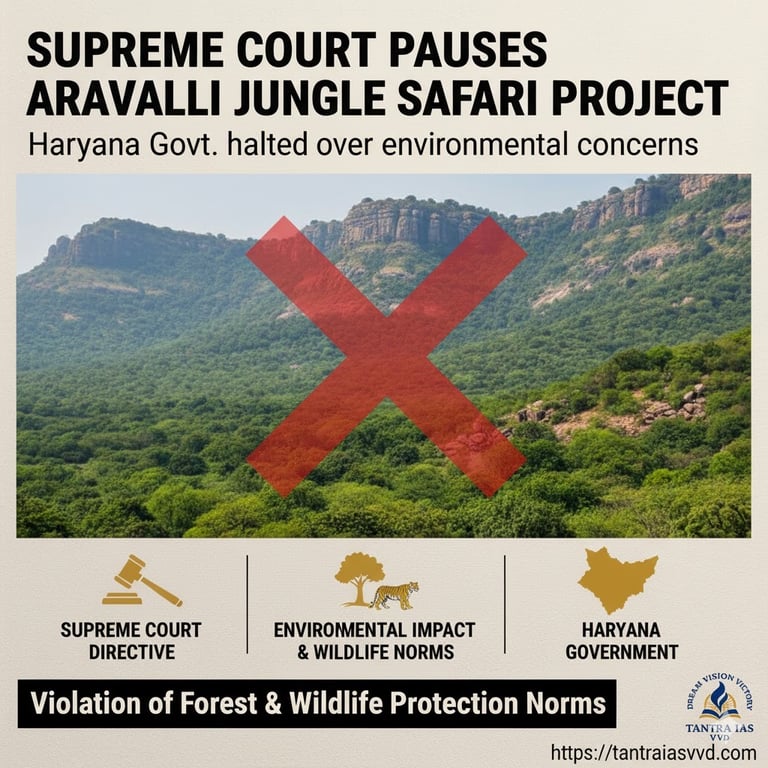

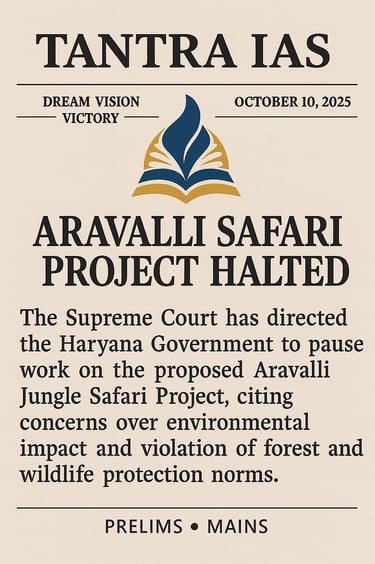

INDIA’S CONNECTIVITY GAP WIDENS (OOKLA 2025 REPORT)
Theme: Governance | Infrastructure | Digital Divide | Inclusive Growth
📰 Context
According to Ookla (2025 H1 Report), rural India’s mobile internet penetration stood at 58.8%, compared to 125.3% in urban areas, highlighting India’s widening digital connectivity gap.
The national average stood at 82.74%, showing persistent inequality in digital access and telecom infrastructure despite cheap data and widespread 4G coverage.
📊 Findings
🔹 Urban vs Rural Divide:
Urban penetration: 125.3% (multi-device, dual SIM usage common).
Rural penetration: 58.8% — only half the population connected.
Gap: 66.5 percentage points.
🔹 Regional Disparities:
High connectivity: Delhi, Goa, Chandigarh.
Low connectivity: Bihar, Dadra & Nagar Haveli, Diu.
🔹 Access ≠ Inclusion:
Availability of telecom networks hasn’t translated into digital empowerment due to affordability, awareness, and literacy gaps.
⚙️ Reasons for the Digital Divide
⚫ Unequal infrastructure rollout (private focus on profit-rich urban zones).
⚫ Low digital literacy & awareness in rural India.
⚫ Gender gap in mobile ownership.
⚫ Poor power supply & weak last-mile connectivity.
⚫ Limited regional-language digital content.
🧭 UPSC Mains Relevance
GS Paper 2:
Government policies and interventions for development.
Issues of governance and service delivery in rural areas.
GS Paper 3:
Infrastructure: Energy, Ports, Roads, Airports, Railways, and Telecommunications.
Inclusive growth and issues arising from it.
💡 Government Initiatives
✅ BharatNet Project: Optical fiber to all gram panchayats.
✅ Digital India Mission: Universal digital literacy and e-governance.
✅ PM-WANI Scheme: Public Wi-Fi hotspots for affordable access.
✅ 5G Bharat Vision 2030: Bridging connectivity across rural clusters.
⚖️ Challenges
⚠️ Infrastructure rollout delays.
⚠️ Weak regulatory oversight in universal service obligations.
⚠️ Underutilisation of funds like USOF (Universal Service Obligation Fund).
⚠️ Lack of indigenous digital ecosystem for rural needs.
🧩 Way Forward
🌐 Focus on “Digital Equity”, not just coverage.
🌐 Promote regional-language content and digital skilling.
🌐 Incentivise private–public partnerships in rural telecom expansion.
🌐 Ensure gender-responsive digital policies.
💬 Conclusion
India’s digital revolution remains urban-centric. To ensure inclusive growth, digital access must become a public utility—as essential as electricity or healthcare.
🧠 Topper’s Toolkit
Keyword: “Connectivity Deficit = Development Deficit.”
Quote: “Digital empowerment of one India must not mean digital exclusion of the other.”
Diagram Idea: Bar chart — Urban vs Rural penetration; Map highlighting high and low connectivity states.
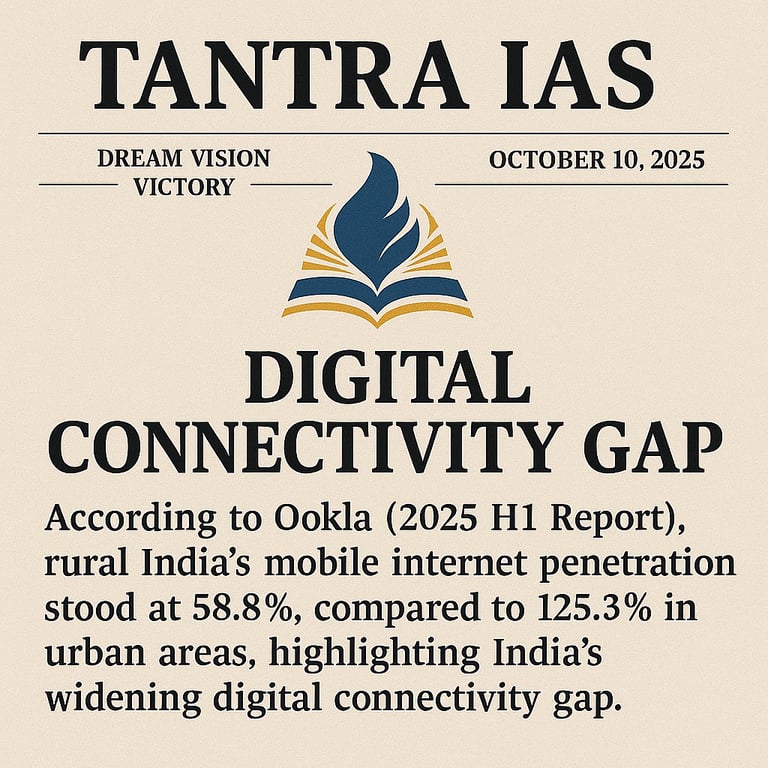

CULTURAL BRIDGE: SOUTH–NORTH INTEGRATION THROUGH MUSIC IN AYODHYA
Theme: Indian Culture | Bhakti Movement | Integration of Arts & Spiritual Traditions
📰 Context
On October 8, 2025, Union Finance Minister Nirmala Sitharaman and UP CM Yogi Adityanath unveiled statues of three eminent South Indian saint-musicians — Purandaradasa, Tyagaraja Swami, and Arunachala Kavi — in Ayodhya, symbolising the cultural unity between North and South India through Ram Bhakti and Carnatic traditions.
About the Saint-Musicians:
1️⃣ Purandaradasa (1484–1564)
Known as the “Father of Carnatic Music.”
Introduced structured music pedagogy (Sarali, Janta, and Alankaras).
Composed devotional songs in Kannada praising Lord Vishnu and Rama.
His works shaped both Karnataka Sangeeta and the Bhakti tradition.
2️⃣ Tyagaraja (1767–1847)
Central figure of the Trinity of Carnatic Music (with Muthuswami Dikshitar and Syama Sastri).
Composed Pancharatna Kritis (five gems) in Telugu devoted to Lord Rama.
Bridged classical technique with spiritual devotion — “Nadopasana” (music as worship).
3️⃣ Arunachala Kavi (1711–1779)
Tamil poet-musician who composed Rama Natakam, a musical drama narrating Ramayana.
Helped shape Tamil devotional art and theatre.
🌉 Significance of the Event
✅ Represents a North–South cultural synthesis centred on Lord Rama and Bhakti.
✅ Highlights Ramayana’s pan-Indian universality across languages and musical forms.
✅ Promotes Ek Bharat Shreshtha Bharat — unity in spiritual and artistic expression.
✅ Connects Ayodhya (North) with Carnatic tradition (South), integrating devotional heritage.
🧭 UPSC Mains Relevance (GS Paper 1)
Art & Culture: Development of music forms and devotional movements.
History: Role of Bhakti saints in socio-cultural unity.
Society: Integration of regional identities through religion & art.
🎯 UPSC Prelims Angles
Purandaradasa → Father of Carnatic Music, Kannada compositions.
Tyagaraja → Pancharatna Kritis, Telugu bhakti compositions.
Arunachala Kavi → Rama Natakam, Tamil musical literature.
All three linked by Rama devotion (Ram Bhakti).
💡 Cultural Insight
“Bhakti transcends region and language — from Ayodhya’s kirtans to Thiruvaiyaru’s kritis, Rama unites India’s musical soul.”
🧩 Conclusion
The installation of these statues at Brihaspati Kund, Ayodhya, symbolises a living cultural dialogue between India’s diverse traditions — reaffirming that art, faith, and unity form the essence of Bharatiya Sanskriti.
🧠 Topper’s Toolkit
Keyword: “Cultural Integration through Bhakti Music.”
Quote: “North sings his glory, South composes his rhythm — both echo one Rama.”
Diagram Idea: Map linking Ayodhya → Karnataka (Purandaradasa) → Andhra (Tyagaraja) → Tamil Nadu (Arunachala Kavi) under “Ram Bhakti.”
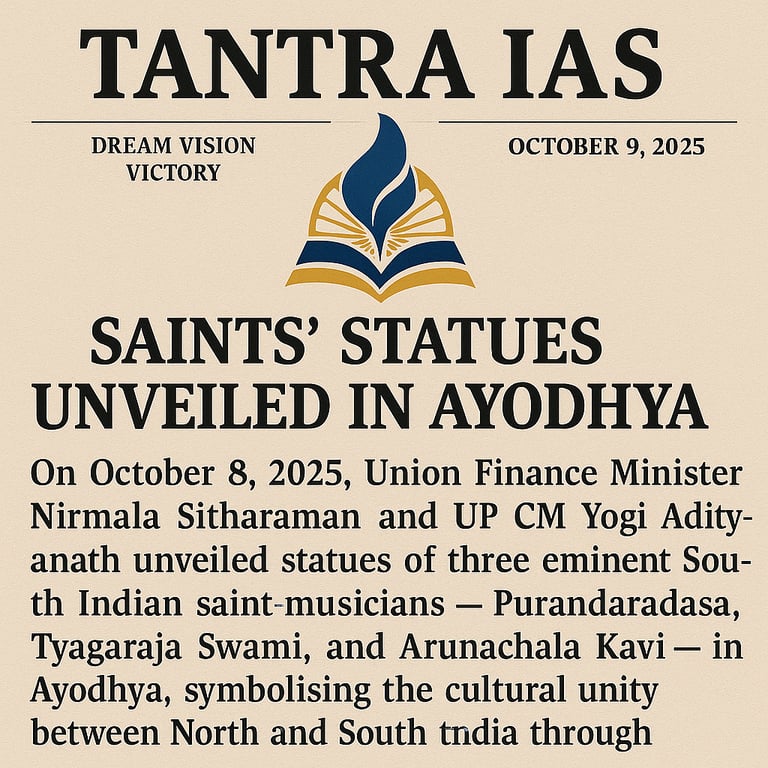

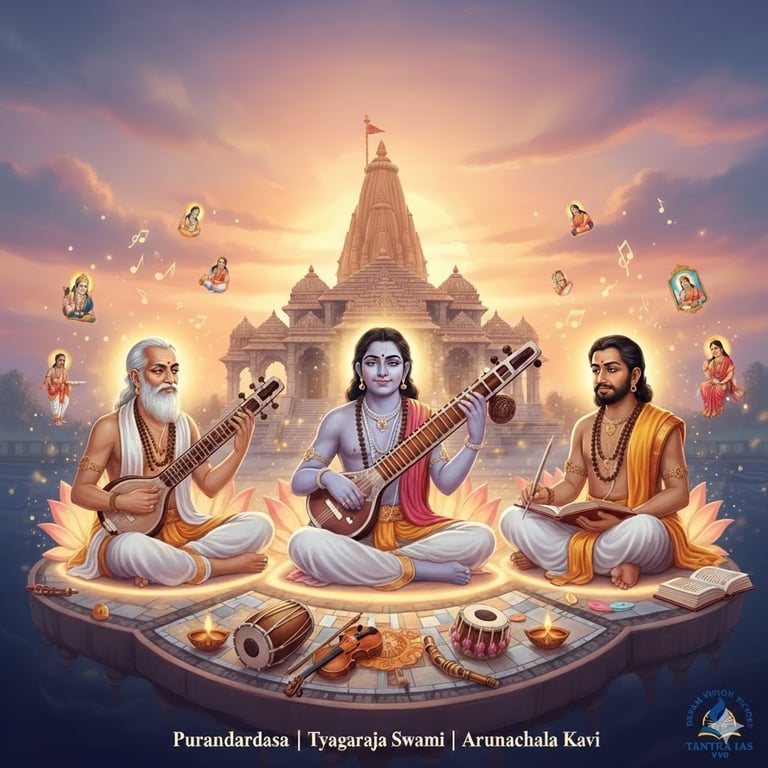

2025 NOBEL PRIZE IN CHEMISTRY:
Theme: Science & Technology | Chemistry | Environmental Sustainability
🧠 Context
The 2025 Nobel Prize in Chemistry has been awarded to Richard Robson (Australia), Susumu Kitagawa (Japan), and Omar M. Yaghi (USA) for their pioneering work on metal–organic frameworks (MOFs) — a revolutionary class of materials that “engineer empty space at the molecular level” to address environmental challenges.
⚙️ What Are MOFs?
🔹 Metal–Organic Frameworks are crystalline compounds made of metal ions linked by organic molecules, forming a porous 3D lattice.
🔹 These frameworks trap, store, or filter gases and molecules due to their tunable nano-sized voids.
🔹 Often called “sponges at the atomic scale.”
💡 Applications
✅ Carbon Capture & Storage (CCS): MOFs absorb CO₂ efficiently, mitigating greenhouse emissions.
✅ Water Harvesting: Capable of extracting moisture from arid air (used in desert water harvesters).
✅ Pollution Control: Capture of VOCs and toxic gases.
✅ Energy Storage: Hydrogen and methane storage for clean fuels.
✅ Catalysis & Drug Delivery: Tunable surfaces aid targeted molecular reactions.
🧭 UPSC Mains Relevance
GS Paper 3:
Science & Technology: Nanomaterials, innovative materials.
Environment: Climate change mitigation, carbon management.
Industry: Sustainable technologies and green chemistry.
Keywords: Metal–Organic Frameworks, Porous Materials, Carbon Capture, Sustainable Chemistry.
🎯 UPSC Prelims Relevance
Possible MCQ Angles:
1️⃣ MOFs are composed of metal ions + organic linkers forming porous networks.
2️⃣ They are used in carbon capture, hydrogen storage, and pollution control.
3️⃣ Discovered by Richard Robson, Susumu Kitagawa, and Omar Yaghi.
4️⃣ Term “Engineering Empty Space” refers to MOF design.
🌍 Significance
MOFs represent a new frontier in “chemistry of emptiness” — using voids to solve material and environmental problems.
Offer scalable solutions for climate resilience, renewable energy, and sustainable industry.
Bridge between materials science and molecular architecture.
⚖️ Challenges
⚠️ High synthesis cost and scalability issues.
⚠️ Thermal and chemical stability under real-world conditions.
⚠️ Limited awareness in industrial adoption.
🧩 Conclusion
The 2025 Nobel Prize celebrates “chemistry that shapes the invisible” — a discipline where molecular voids are engineered for human survival, transforming chemistry from a science of matter to a science of possibility.
🧠 Topper’s Toolkit
Keyword: “Engineering emptiness for environmental resilience.”
Quote: “Science begins not with what we see, but with what we shape in the unseen.”
Diagram Idea: MOF structure showing metal nodes + organic linkers + voids trapping CO₂ molecules.
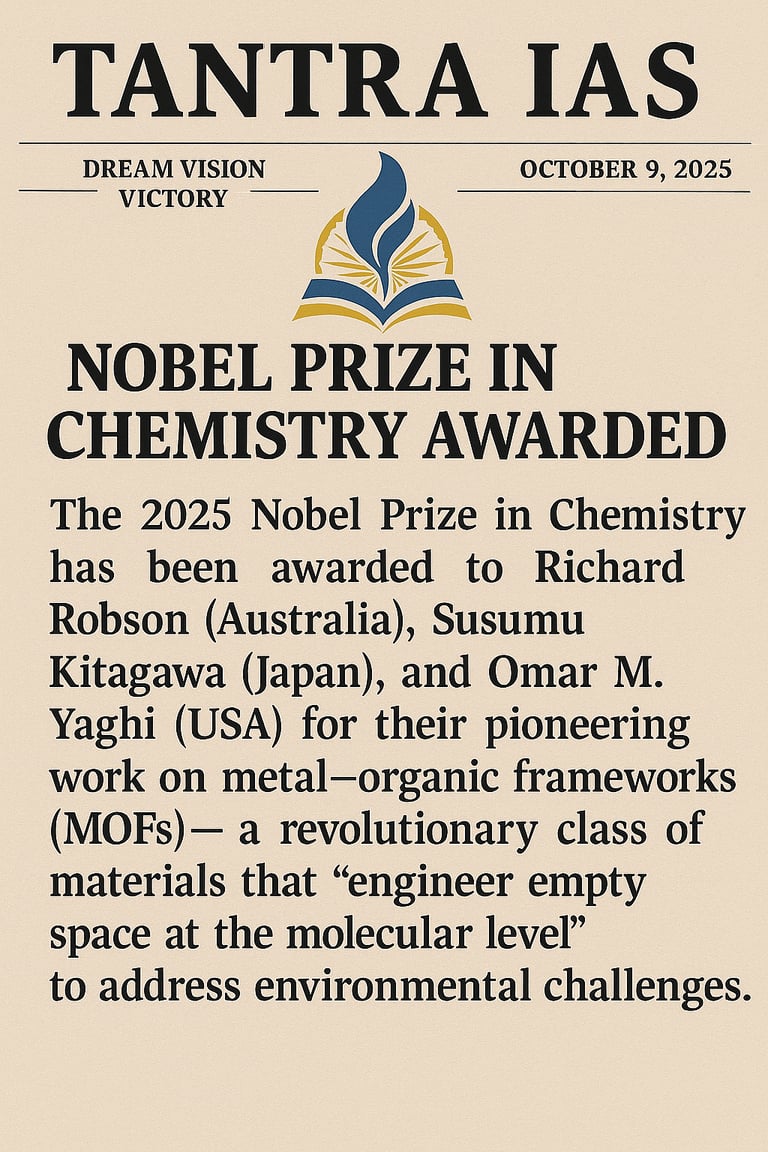

🗺️ PLACES IN THE NEWS — BAGRAM AIR BASE (AFGHANISTAN)
📍 WHERE IS THIS BAGRAM LOCATED?
In Afghanistan:
Province: Parwan Province, about 65 km north of Kabul (the capital).
Coordinates: Approx. 34°56′N 69°15′E
Situated in the Shomali Plain, close to the Hindu Kush mountains.
(On your world/Afghanistan map — mark it slightly north of Kabul.)
⚙️ Strategic Importance:
Largest military base in Afghanistan; built by the Soviets in the 1950s, expanded during the US-led war (2001–2021).
Served as headquarters for US & NATO forces during the “War on Terror.”
Equipped with two runways, surveillance facilities, and detention infrastructure.
After the US withdrawal (2021), control passed to the Taliban.
🌍 Geo-Politics:
India, Russia, China, Pakistan, and others opposed US re-deployment plans at Bagram during the Moscow Format consultations on Afghanistan.
India’s stance: deployment of foreign forces would “destabilise regional peace.”
Symbolic of regional consensus against renewed Western military presence.
🧭 UPSC Relevance:
GS Paper 2: India & its Neighbourhood, Regional Groupings, Foreign Policy.
GS Paper 3: Internal Security, Counter-terrorism cooperation.
Prelims Tip: Bagram is not in Kabul province — it’s in Parwan Province.
🧠 Mnemonic
👉 “Bagram Beyond Kabul” — remember: north of Kabul, near Hindu Kush.
UPSC PYQs:
Q. Consider the following pairs :
Towns sometimes mentioned in news Country. (UPSC PRE-2018)
1. Aleppo: Syria
2. Kirkuk: Yemen
3. Mosul: Palestine 4. Mazar-i-sharif: Afghanistan
Which of the pairs given above are correctly matched?
[A] 1 and 2
[B] 1 and 4
[C] 2 and3
[D] 3 and 4
Answer: B
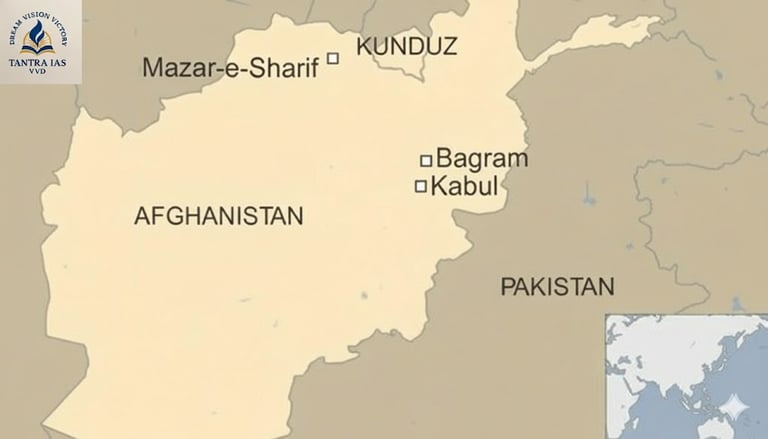

INDIA & THE MOSCOW FORMAT: AFGHANISTAN POLICY REALIGNMENT
Theme: International Relations | India & Its Neighbourhood | Global Groupings & Agreements
📰 Context
In a significant diplomatic move, India joined the Moscow Format Consultations alongside Russia, China, Pakistan, Iran, and the Taliban regime, issuing a joint statement opposing the US plan to deploy military infrastructure in Afghanistan — particularly at the Bagram Airbase.
This marks a rare instance where India aligned with regional actors including the Taliban, reflecting nuanced strategic recalibration in the Afghan peace process.
⚙️ About the Moscow Format
🔹 Established in 2017, led by Russia, to foster regional consensus on Afghan stability.
🔹 Includes India, Iran, Pakistan, China, Russia, and Central Asian nations.
🔹 Focus: Counter-terrorism, narcotics control, inclusive government, humanitarian aid, and regional security.
🧭 India’s Position
✅ Strategic Recalibration: Pragmatic engagement with the Taliban regime while avoiding formal recognition.
✅ Regional Stability Focus: Opposes foreign (US/NATO) military presence, aligning with Eurasian security interests.
✅ Humanitarian Assistance: Continued aid via UN agencies — wheat, medicine, and vaccines.
✅ Balancing Act: Supports Afghan sovereignty while maintaining concerns over Pakistan’s influence.
🧩 UPSC Mains Relevance
GS Paper 2:
India’s neighbourhood policy.
Bilateral & multilateral diplomacy.
Effect of policies of developed countries (US) on India’s interests.
Role of regional groupings (Moscow Format, SCO).
Themes:
“India’s strategic autonomy in multipolar Asia.”
“Balancing values with realpolitik in Afghanistan.”
🎯 UPSC Prelims Relevance:
Possible MCQ Angles:
1️⃣ Moscow Format is a regional mechanism for Afghan peace led by Russia.
2️⃣ India participated in the 2025 meeting alongside China, Iran, Pakistan, and Taliban representatives.
3️⃣ Bagram Airbase is located in Afghanistan, formerly used by the US forces.
4️⃣ India’s aid to Afghanistan is channelled through UN World Food Programme and WHO.
💡 Significance for India
✅ Prevents US re-entry into the Afghan theatre.
✅ Strengthens India’s role in Eurasian security architecture.
✅ Protects regional interests through dialogue over confrontation.
✅ Expands India’s diplomacy via “strategic pragmatism” — engaging without endorsement.
⚖️ Challenges
⚠️ Legitimacy dilemma — engaging Taliban without formal recognition.
⚠️ China–Pakistan bloc dominance in Afghan affairs.
⚠️ Limited on-ground leverage compared to 2001–2021 era.
🧩 Conclusion
India’s participation in the Moscow Format reflects a realist shift — from moral distance to strategic dialogue. It reaffirms India’s commitment to regional peace and sovereignty over unilateral interventions, while keeping counter-terrorism and stability at the forefront.
🧠 Topper’s Toolkit (Value Add)
Keyword: “Strategic Pragmatism.”
Quote: “In diplomacy, engagement is not endorsement — it’s an instrument of influence.”
Diagram Idea: Map — Moscow Format participants + India’s multi-alignment strategy in Eurasia.
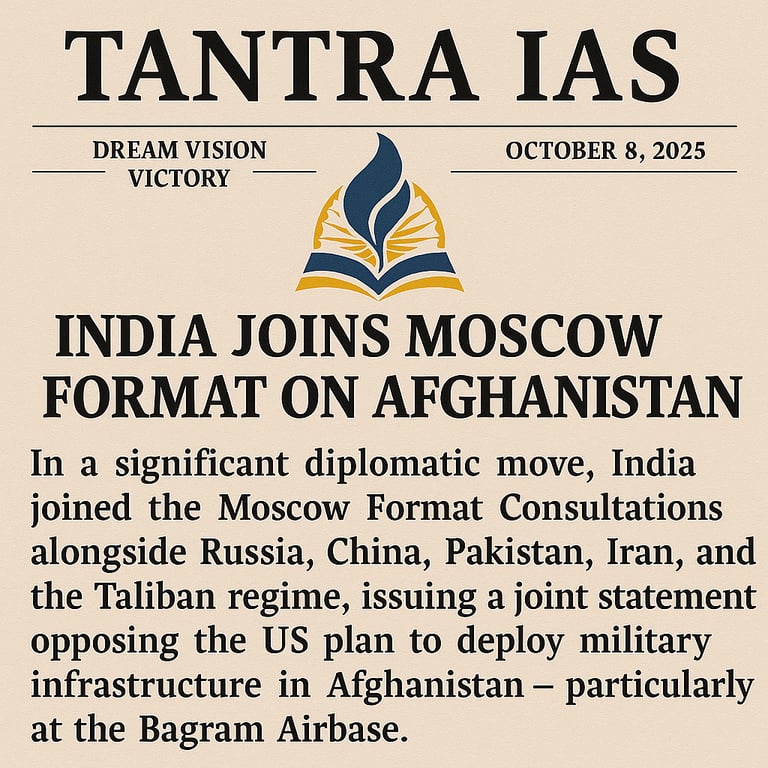

SPURIOUS COUGH SYRUPS & INDIA’S DRUG REGULATION CRISIS.
Theme: Health Sector | Governance | Regulatory Mechanisms | Ethics in Public Administration.
🧬 Context
Deaths of 14 children in Madhya Pradesh and Rajasthan (2025) due to contaminated cough syrups once again exposed gaps in India’s drug quality control system.
This follows a disturbing pattern — similar tragedies in Gambia (2022) and Uzbekistan (2023) linked to diethylene glycol (DEG) contamination in Indian-made syrups.
⚙️ The Issue
🔹 Toxic Ingredient: Diethylene glycol (DEG) — a solvent that causes acute kidney failure when consumed.
🔹 Regulatory Failure: Inadequate testing, poor coordination between state drug controllers and CDSCO (Central Drugs Standard Control Organisation).
🔹 Global Fallout: Export bans, reputational damage to India’s pharma sector.
🔹 Industry Paradox: India — “pharmacy of the world” — yet faces rising cases of spurious or substandard drugs domestically and abroad.
📊 Key Facts & Data
India supplies 40% of generic drugs to the US and 20% of global generics.
DEG-related deaths: Over 300 worldwide (past 30 years).
WHO flagged critical lapses in drug testing & traceability post-COVID.
Over 8% of India’s sampled drugs failed quality tests (CDSCO 2024 data).
🧭 UPSC Mains Relevance
GS Paper 2:
Issues relating to health, regulation & governance.
Role of statutory bodies (CDSCO, NPPA).
Accountability & ethical governance in public administration.
GS Paper 3:
Biotechnology & health research applications.
Industrial policy and pharma exports.
GS4 (Ethics):
Conflict between profit motive & public safety.
Ethical responsibility of regulators and manufacturers.
💡 Significance
✅ Urgent need for uniform national drug regulatory standards.
✅ Strengthen Central–State coordination for real-time product testing.
✅ Adoption of QR-based traceability for every medicine batch.
✅ Empower Drug Regulatory Authority of India (DRAI) with statutory autonomy.
✅ Ensure ethical accountability within the pharma sector.
⚖️ Challenges
⚠️ Fragmented federal structure for drug control.
⚠️ Weak enforcement & staff shortages in testing labs.
⚠️ Overdependence on exports — neglect of domestic oversight.
⚠️ Public trust erosion in “Make in India” pharma products.
🧩 Conclusion
India’s image as the “pharmacy of the world” cannot rest on low-cost mass production alone. Quality, ethics, and transparency must form the new foundation of Pharma 2.0 — where public health trumps profit.
🧠 Topper’s Toolkit (Value Add)
Keyword: “Pharma without ethics is a prescription for disaster.”
Quote: “Regulation is not a hurdle to innovation — it is its moral compass.”
Diagram Idea: Flowchart → Drug Manufacture → Testing → Export → Regulatory Failure → Policy Reform.
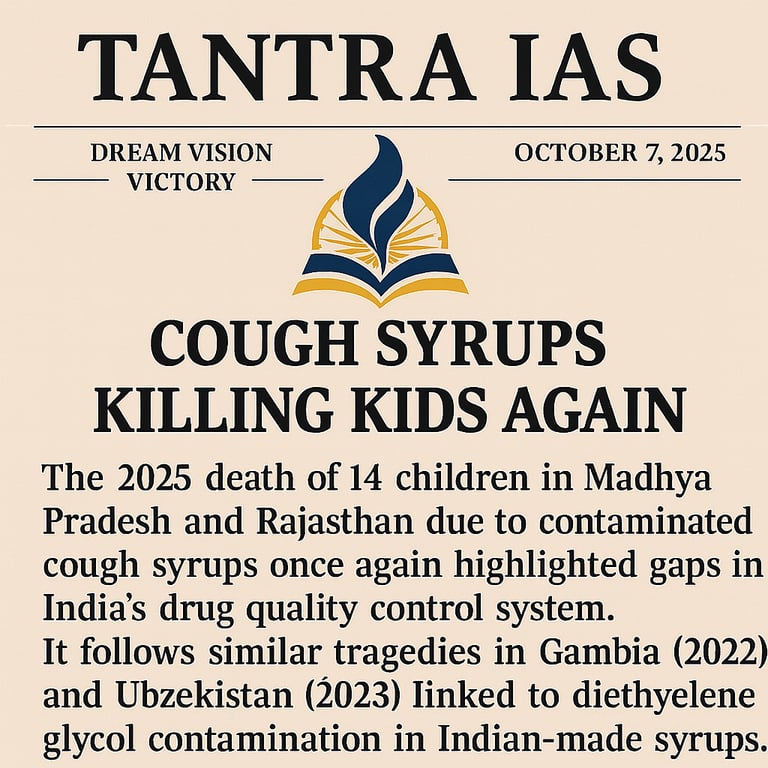

💧 WATER CONSERVATION PRIORITISED UNDER MGNREGA
Theme: Government Policies & Interventions | Rural Development | Sustainable Water Management.
📰 Context
The Central Government has amended the Schedule of the Mahatma Gandhi National Rural Employment Guarantee Act (MGNREGA), 2005, to prioritise water conservation and harvesting works in rural areas.
The Ministry of Rural Development (MoRD) notified this policy change on September 23, 2025.
⚙️ Key Highlights of the Amendment
🔹 New Focus: Rural water assets — check dams, percolation tanks, ponds, and recharge wells.
🔹 Minimum Share: 60% of MGNREGA works must now relate to agriculture and water conservation.
🔹 Groundwater Stress Priority: Over-exploited and semi-critical blocks will receive preferential funding.
🔹 Integrated Implementation: Linked with the Jal Shakti Abhiyan, Atal Bhujal Yojana, and PM Krishi Sinchai Yojana.
💦 Objectives
✅ Strengthen water resilience and sustainable rural livelihoods.
✅ Reduce dependence on monsoons and enhance farm productivity.
✅ Create durable community assets to tackle drought and climate stress.
✅ Promote convergence between environmental regeneration and employment.
🧭 UPSC Mains Relevance
GS Paper 2: Welfare schemes for vulnerable sections; issues in implementation.
GS Paper 3: Conservation of natural resources, Environmental impact and rural development synergy, Climate change adaptation through water management.
🎯 UPSC Prelims Pointers
Implementing Ministry: Ministry of Rural Development (MoRD).
Legal Backing: Section 16, Schedule I of the MGNREGA, 2005.
Key Classification:
Over-exploited blocks → >100% groundwater extraction.
Critical blocks → 90–100%.
Semi-critical → 70–90%.
MGNREGA Asset Types: Water harvesting, afforestation, flood control, and irrigation channel repair.
💡 Significance
✅ Aligns wage employment with long-term resource creation.
✅ Tackles India’s water crisis — over 70% districts water-stressed.
✅ Encourages decentralised, people-led water management.
✅ Strengthens climate adaptation under LiFE (Lifestyle for Environment).
⚖️ Challenges
⚠️ Skill & monitoring gaps at panchayat level.
⚠️ Delays in fund release and capacity building.
⚠️ Need for transparency in work prioritisation.
🧩 Conclusion
The amendment transforms MGNREGA into a “Water Security Employment Mission”, ensuring that livelihood generation and ecological balance go hand in hand — a critical step toward climate-smart rural governance.
🧠 Topper’s Toolkit (Value Add)
Keyword: “MGNREGA 2.0 — from Wage Security to Water Security.”
Quote: “Water is the foundation of both life and livelihoods.”
Diagram Idea: Flow → MGNREGA Amendment → Water Projects → Livelihood + Sustainability + Resilience.
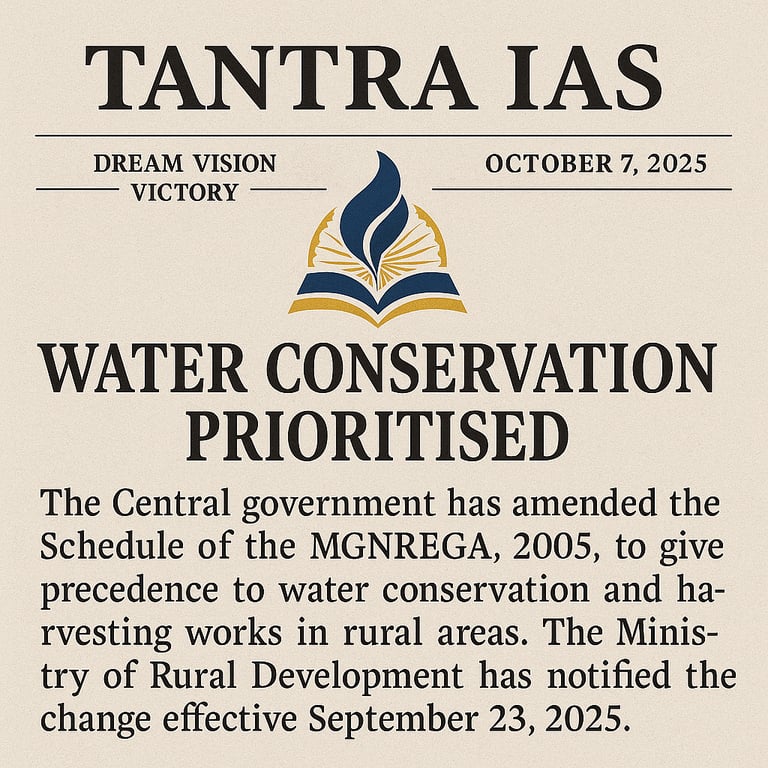

2025 NOBEL PRIZE IN MEDICINE
Theme: Science & Technology | Biotechnology | Human Physiology
🧠 Context
The 2025 Nobel Prize in Physiology or Medicine was awarded to Mary E. B. Runkow (USA), Frederick Ramsdell (USA), and Shimon Sakaguchi (Japan) for discovering Regulatory T Cells (Tregs) — the “police cells” that prevent the immune system from attacking the body’s own tissues.
⚙️ Key Discovery
🔹 Regulatory T Cells (Tregs): A subset of white blood cells that maintain immune tolerance — preventing the immune system from damaging self-tissues.
🔹 Gene Identified: FOXP3 — the master gene that controls Treg development.
🔹 Function: Tregs suppress overactive immune responses that can cause autoimmune diseases such as type-1 diabetes, rheumatoid arthritis, multiple sclerosis, and lupus.
🔹 Mechanism: They act as “brakes” of the immune system — balancing attack and restraint.
🔍 UPSC Mains Relevance (GS Paper 3)
Science & Technology: Developments in biotechnology & health research.
Health Sector: Understanding autoimmune disorders & immune regulation.
Applications: Future scope in immunotherapy, organ transplantation, and cancer treatment.
🎯 UPSC Prelims Relevance
Possible MCQ Angles:
1️⃣ 2025 Nobel Prize awarded for discovery of Regulatory T Cells (Tregs).
2️⃣ FOXP3 gene is associated with development of immune tolerance.
3️⃣ Function of Tregs → prevent immune system from attacking self-tissues.
4️⃣ Shimon Sakaguchi first identified Tregs in the 1990s.
5️⃣ Autoimmune diseases arise when immune tolerance fails.
💡 Significance
✅ Deeper understanding of immune balance → better treatment of autoimmune diseases.
✅ Foundation for next-generation cell-based immunotherapies.
✅ May lead to customised immune modulation in cancer & organ transplant medicine.
✅ Reinforces India’s focus on immunology under National Biotech Development Strategy 2025.
⚖️ Ethical Dimensions (GS4 Link)
Balancing medical innovation with safety & equity.
Ethical trials in gene therapy & immune modulation.
Access to immunotherapies in low-income nations.
🧩 Conclusion
This Nobel-winning discovery unravels one of biology’s deepest puzzles — how the immune system knows when to fight and when to stand down. It opens the path to curing autoimmune diseases through precision immunology.
🧠 Topper’s Toolkit (Value Add)
Keyword: “Immune tolerance through Regulatory T cells.”
Quote: “The immune system’s greatest strength is knowing its limits.”
Diagram Idea: Immune balance — Active T Cells vs Regulatory T Cells.


🚀 GAGANYAAN: INDIA’S LEAP INTO SPACE
Theme: Science & Technology | Indigenisation | Space Technology
🌍 Context
Gaganyaan Mission, led by ISRO, aims to send a 3-member Indian crew into low Earth orbit (400 km) for 3 days and bring them safely back to Earth. It represents India’s entry into the elite group of nations with human spaceflight capability — after the USA, Russia, and China.
🛰️ Features
🔹 Crew Module (CM): Pressurised capsule carrying astronauts with life support and emergency systems.
🔹 Service Module (SM): Supplies power, propulsion, and thermal control.
🔹 Launch Vehicle: HLVM3 (Human-rated LVM3).
🔹 Training: Astronauts trained in India and Russia; Gaganyaan Astronaut Training Facility in Bengaluru.
🔹 Safety Systems: Crew Escape System (CES) tested successfully.
🔹 Mission Partners: ISRO, DRDO, HAL, BEL, IN-SPACe, and private tech firms.
⚙️ Objectives
✅ Validate indigenous spaceflight capability.
✅ Strengthen aerospace R&D, robotics, and life-support systems.
✅ Inspire youth & promote STEM innovation.
✅ Build international collaboration for deep space missions (e.g., LUPEX, Chandrayaan-Next).
🧭 UPSC Mains Relevance (GS Paper 3):
Science & Technology: Achievements of Indians in space technology.
Indigenisation: Development of indigenous launch vehicles & space tech.
Security: Strategic & scientific self-reliance under “Atmanirbhar Bharat”.
🎯 UPSC Prelims Relevance:
Possible MCQ Angles:
1️⃣ Gaganyaan involves Human-rated LVM3 launch vehicle.
2️⃣ Crew Module designed for re-entry & safe landing in Indian Ocean.
3️⃣ Mission partners include ISRO, DRDO, HAL, BEL.
4️⃣ Training collaborations with Russia’s Gagarin Cosmonaut Training Center.
5️⃣ HLVM3 stands for Human Launch Vehicle Mark-3.
💡 Significance
✅ Positions India as a global space power.
✅ Boosts indigenous innovation & manufacturing.
✅ Expands private sector & academia participation in space ecosystem.
✅ Strengthens “IndiaAI” & advanced robotics integration for future missions.
⚖️ Challenges
⚠️ High cost & complexity (~₹9,000 crore).
⚠️ Astronaut safety, life support validation, re-entry precision.
⚠️ Maintaining global cooperation amid strategic competition.
🧩 Conclusion
Gaganyaan is not just a space mission — it’s India’s declaration of scientific confidence, technological maturity, and visionary ambition.
🧠 Topper’s Toolkit
Keyword: “Human-rated launch vehicle.”
Quote: “Space exploration is the ultimate expression of human curiosity and courage.”
Diagram Idea: Gaganyaan architecture — Crew Module, Launch Vehicle, Orbital Path.
UPSC PYQ:
Q. Consider the following space missions: (UPSC PRE-2025)
I. Axiom-4
II. SpaDeX
III. Gaganyaan
How many encourage mesogravity research?
Only one
Only two
All three
None
ANSWER: Option 3: All three.
Explanation: All three missions — Axiom-4, SpaDeX, and Gaganyaan — encourage mesogravity (microgravity/low-gravity) research.
Axiom-4: Conducts multiple microgravity experiments aboard the International Space Station (ISS) related to human physiology and space biotechnology.
SpaDeX (Space Docking Experiment): Though primarily a technology demonstrator for autonomous docking, it also carries several payloads designed for experiments utilizing the microgravity environment in orbit.
Gaganyaan: India’s human spaceflight programme aims to facilitate a range of microgravity experiments in life sciences, material sciences, and space medicine through its orbital module.
✅ Final Answer: 3
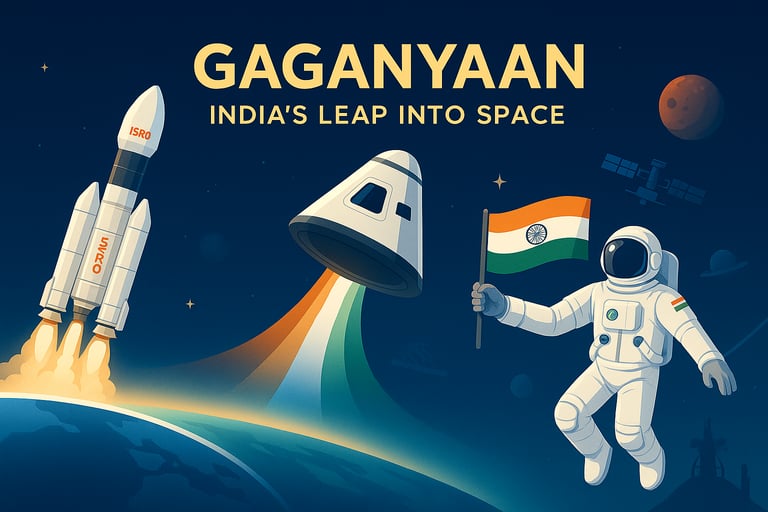

DAILY UPDATES
UPSC CURRENT AFFAIRS
MISSION SUDARSHAN CHAKRA
Theme: Internal Security | Science & Technology | Defence Infrastructure
⚡ Context
India’s Mission Sudarshan Chakra will establish a nationwide multi-layered air defence shield by linking 6,000–7,000 radars, satellites, and directed-energy weapons (DEWs). It represents a landmark move towards an indigenous, technology-driven defence ecosystem.
⚙️ Key Features
🔹 Layered Shield: Tracks aerial threats beyond the horizon through an integrated radar-satellite-AI network.
🔹 Satellites: Enable real-time surveillance of hostile launches and incursions.
🔹 Directed Energy Weapons (DEWs): Laser-based systems to neutralise enemy drones and missiles.
🔹 Integration: Combines radars, DEWs, anti-drone systems, and air-defence guns.
🔹 Institutions Involved: DRDO, ISRO, BEL, armed forces, paramilitary, and defence PSUs under a unified Strategic Coordination Framework.
🧭 UPSC Mains Relevance (GS Paper 3)
Internal Security: Modernisation of armed forces; defence preparedness.
Science & Technology: Application of lasers, AI, and radar technology in national security.
Indigenisation: “Atmanirbhar Bharat” in defence R&D and production.
🎯 UPSC Prelims Relevance
Possible MCQ Angles:
1️⃣ Mission Sudarshan Chakra is related to → Integrated national air defence shield.
2️⃣ Directed Energy Weapons use → High-energy lasers or microwaves to disable targets.
3️⃣ DEWs differ from conventional missiles as they rely on energy beams, not kinetic projectiles.
4️⃣ Agencies involved → DRDO + ISRO + defence PSUs (BEL, HAL).
5️⃣ Objective: Multi-layered protection against aircraft, drones, and ballistic missiles.
💡 Significance
✅ Boosts national security & technological sovereignty.
✅ Detects and neutralises cross-border aerial threats early.
✅ Strengthens India’s deterrence posture and regional stability.
✅ Builds synergy between civil–military research.
⚖️ Challenges
⚠️ High development cost & tech complexity.
⚠️ Cyber-vulnerability of integrated networks.
⚠️ Need for interoperability & unified command.
⚠️ Potential for global weaponisation of space.
🧩 Conclusion
Mission Sudarshan Chakra symbolises India’s transition from reactive defence to proactive deterrence, positioning it among the few nations pursuing energy-based, AI-integrated air-defence systems.
🧠 Topper’s Toolkit (Value-Add)
Keyword: “Layered Air-Defence Architecture.”
Quote: “Technology is the new frontier of sovereignty.”
Diagram Idea: Circular radar-satellite grid showing integration of DEWs, radars & command nodes.
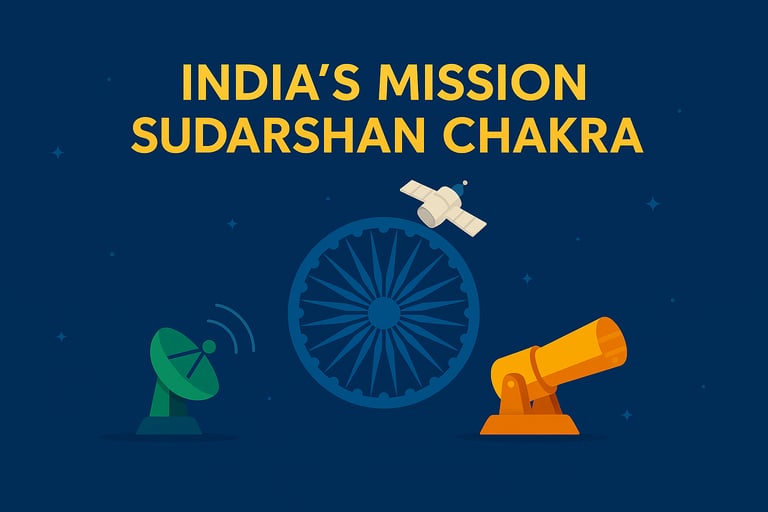

DAILY UPDATES
UPSC CURRENT AFFAIRS
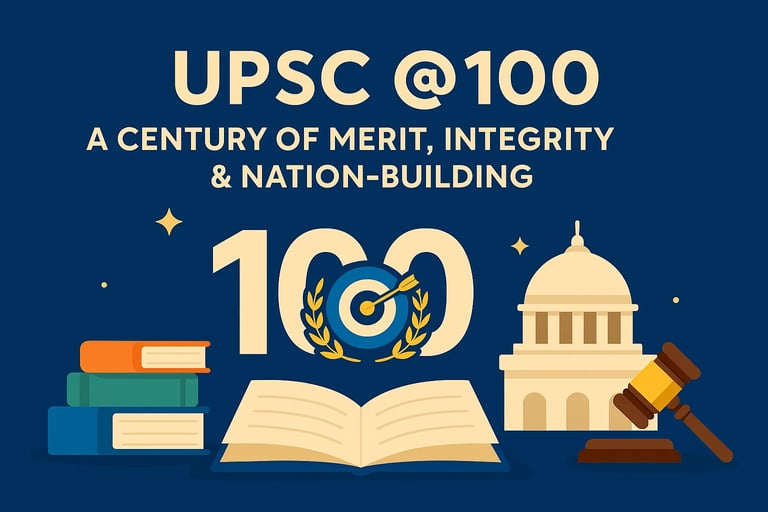

UPSC @100 – From Selection to Transformation
Context:
As UPSC completes 100 years (1925–2025), it stands as India’s longest-surviving symbol of meritocracy, neutrality, and institutional integrity. Its evolution reflects how governance in India has shifted from colonial control to ethical, citizen-centric administration.
Syllabus Mapping:
Prelims:
Indian Polity & Governance → Constitutional Bodies (Articles 315–323)
Current Affairs → Administrative reforms, transparency, recruitment innovations
History → Development of modern civil services
Economy → Public administration, fiscal efficiency, HR reforms
Mains:
GS II: Role & functions of constitutional bodies, reforms in civil services
GS IV: Integrity, impartiality, public service values
Essay: Institutional trust, governance ethics, meritocracy
GS I / GS III (linkages): Administrative evolution, technological governance
